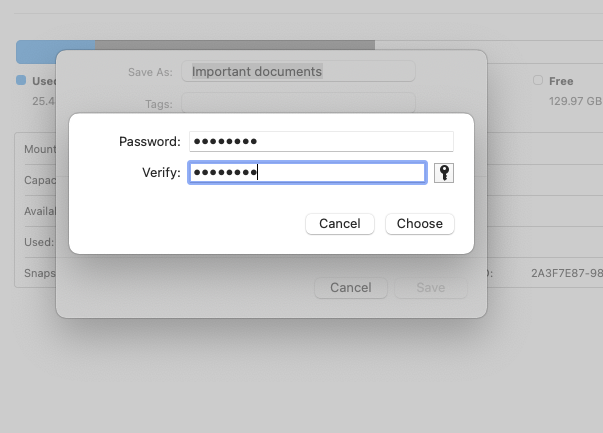Data can have real value, and like anything valuable, sometimes it needs to be kept locked away — to stop other people looking at or stealing it. For example, if you have sensitive content or secret projects stored on your Mac, you’ll want to stop people from opening them.
That’s especially true if you share your Mac with other people, but computers are also vulnerable to privacy breaches from outside forces. Thankfully, it’s easy to password protect files and folders on your Mac using built-in or third-party tools. And because you’ll encrypt the data at the same time, you’ll make it unreadable to anyone who doesn’t have your password.
Before we start
Concerned about your privacy? Try MacKeeper. It includes a complete virtual private network (VPN) tool, which keeps your web traffic secret, while also hiding your location. That means no one, not even your internet provider, can spy on you. It also offers security, optimization, junk cleaning, and more.
How to password protect folders on your Mac
Password protecting Mac folders rather than individual files is useful for a couple of reasons. As well as letting you lock multiple files or folders at once, it means you can easily add and remove files from your password-protected folder at any time.
Password protecting Mac files with built-in tools
Creating a password protected folder is easy using macOS’s built-in Disk Utility. It simply creates a .dmg archive file, using AES encryption, which you can only open with a password.
Here’s how to password protect folders with Disk Utility:
- Open Disk Utility from Applications > Utilities > Disk Utility.
- From the menu bar, select File > New Image > Image from Folder.
- Now select the folder you want to password protect, and click Choose.
- If you want to, choose a name or location for your protected folder. Open the Encryption, dropdown menu, and make a choice (128-bit AES encryption should be enough), and click Save.
- Enter a password, and click Choose when you’re done.
- Alternatively, click the key icon, and let macOS create a strong password for you. Again, click Choose when you’re finished.
- Expand Image Format and choose read/write. This will let you add and remove content from your protected folder later.
- Finally, click Save.
- Wait for Disk Utility to finish encrypting your folder .
- When it’s done, you’ll be left with a password protected disk image and the original folder. If you don’t need the old folder, you can delete it.
- To open the locked folder on your Mac, simply double-click the .dmg file to open it, then enter your password when requested. With the correct password, the disk image will mount, and you’ll be able to access the contents, including adding or removing files and folders.











Password protecting Mac files with third-party tools
If you want more features, you might want to consider a third-party app to password-protect folders on your Mac. Another big drawback with the Disk Utility method is that anyone can find and even delete your password-protected folders. Third-party apps may help you to get around these limitations.
Check out these third-party apps if you want to lock folders on your Mac:
- Encrypto (free)
- Folder Lock (free with in-app purchases)
- Concealer ($19.99)
- Data Guardian (from $1.83 per month)
- AppCrypt (from $29.99)
- VeraCrypt (free)
How to password protect individual files on Mac
Most of the time, it’s easier just to encrypt and lock Mac folders rather than trying to password-protect individual files. But if you only want to protect one or two files, it might make sense to do it this way instead.
Password protecting files using built-in Mac tools
macOS doesn’t actually have any way to do this, but you can lock individual files using certain native apps, like Notes, Pages and Numbers.
Simply follow these steps:
- In Pages, Numbers and Keynote, choose Files > Set Password from the menu bar. Enter a password, and click Set Password

- In Notes, right-click on a note, then select Lock Note. Enter a password, and select Set Password

Password protecting files with third-party tools
Similar to native apps, often the best way to password protect individual files is to use the apps they were created in.
For example, you can password protect files in:
- Microsoft Office
- Open Office
- LibreOffice
You can also encrypt and password protect files in Encrypto, but it just creates a locked version, leaving the old, unlocked version behind.
Conclusion
It’s useful to be able to password protect individual files in apps like Office, but most of the time, it’s easier and more convenient to lock whole folders on your Mac. That way, you can add and remove files from your protected archive whenever you want, and you only have to remember one password for everything in each locked folder.
If you don’t need any special features, then Disk Utility will be just fine for most purposes. Third-party encryption tools are worth checking out, particularly as ones like Encrypto and VeraCrypt are available free of charge.
Whatever you do, make sure to use strong passwords to protect your valuable data. After all, there’s no point in password protecting your Mac files and folders if your password is easy to crack.
You can also protect your privacy further with MacKeeper. Its built-in VPN client will encrypt your web traffic and hide your location. It also has an ID Theft Guard feature, which alerts you if your website login details are stolen or uploaded to the web by hackers. Plus it offers all kinds of other features to keep your Mac in tip-top condition.








